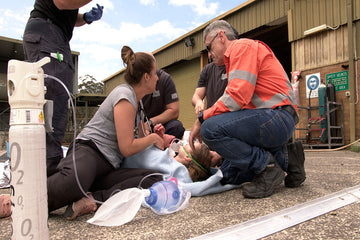Introduction
In today's busy office, making sure the security and health of your labor force is extremely important. One facet that typically obtains overlooked is hand-operated handling, which refers to the procedure of training, bring, pushing, or drawing things. In this article, we will check out effective hand-operated handling methods that can aid maintain your workforce safe and healthy and balanced. We will certainly likewise go over the value of emergency treatment training, consisting of CPR training and mental health first aid, and just how these elements contribute to a much safer job environment.
Manual Handling Methods: Maintaining Your Workforce Safe and Healthy
Manual handling techniques are necessary for stopping injuries in the workplace. Inappropriate lifting methods can bring about musculoskeletal disorders (MSDs), which account for a considerable number of office injuries. To successfully reduce dangers related to hands-on handling, organizations should apply training programs that emphasize appropriate techniques.
Understanding Manual Taking care of Risks
Before diving right into specific strategies, it's essential to acknowledge the risks involved in manual handling cpr lvr - First Aid Workplace Training jobs. According to research, inadequate training practices can lead to:
- Back pain Muscle strains Joint injuries Chronic conditions impacting mobility
Recognizing these dangers allows employers and employees alike to focus on safety.
The Significance of Training
Training plays a crucial role in decreasing hands-on handling-related injuries. It's not almost understanding just how to raise properly; it's additionally about comprehending body technicians and ergonomics. A thorough manual handling training program ought to cover:
- Proper lifting techniques Risk assessment skills Use of devices like trolleys or forklifts
Additionally, including first help courses into work environment training makes sure that everyone understands how to react properly in situation of an injury.

Basic Raising Techniques
Here are some fundamental techniques that everybody need to grasp:

1. Assess the Load
- Before training anything, always evaluate its weight and shape. If it appears also heavy or awkwardly shaped, seek aid or use mechanical aids.
2. Positioning
- Stand near the object. Place your feet shoulder-width apart for balance. Bend your knees while keeping your back straight.
3. Grip
- Ensure a firm hold on the object. Use both hands when possible.
4. Lifting
- Lift with your legs instead of your back. Keep the object close to your body as you stand up.
5. Carrying
- Maintain a steady position while walking. Avoid turning your body; instead, transform your whole body by moving your feet.
6. Setting Down
- Lower the item by flexing at the knees again. Ensure that you place it down delicately without dropping it.
Using Equipment for Hand-operated Handling
Investing in tools created for hands-on handling can substantially reduce injury threat. Here's a listing of frequently used devices:
|Equipment Kind|Purpose|| ----------------|--------------------------------------|| Trolleys|For delivering hefty things|| Raises|For lifting people or hefty objects|| Pallet Jacks|For relocating palletized lots|
Incorporating First Aid Training
While decreasing dangers with correct manual handling is important, being planned for emergencies is just as vital. This is where first aid training enters play.
Types of Emergency treatment Courses Available
General Work environment First Aid
- Covers basic first aid skills needed in various work environments.
CPR Training
- Teaches lifesaving cardiopulmonary resuscitation techniques necessary during heart emergencies.
Corporate Emergency treatment Training
- Tailored programs specifically developed for corporate atmospheres concentrating on usual office injuries.
Mental Health and wellness First Aid
- Provides abilities to assist colleagues struggling with psychological health and wellness concerns-- an essential part commonly overlooked in conventional emergency treatment courses.
Childcare First Aid Course
- Focuses on replying to emergencies entailing children-- perfect for those working in academic setups or childcare centers.
Online Emergency treatment Course
- Offers flexibility for staff members to learn at their own rate while still covering all needed content.
Creating a Culture of Safety
To preserve an environment for safety, cultivating a culture where staff members feel equipped to speak out regarding risks is essential.
1. Encourage Open Communication
Encourage employees to report unsafe conditions without concern of retribution; this fosters an open dialogue about potential risks associated with hand-operated handling tasks.
2. Regular Training Sessions
Hold regular workshops on hand-operated handling methods and refreshers on emergency treatment courses-- keeping skills sharp makes sure preparedness throughout emergencies.
3. Promote Mental Well-being
Since psychological wellness plays a key function in general well-being, employers should promote psychological wellness recognition along with physical safety and security measures.
FAQs
Q1: What are the indications that I need hand-operated dealing with training?
A1: If employees regularly lift hefty items or report pain after lifting tasks, it's time for extensive manual handling training sessions.
Q2: Just how often ought to we conduct emergency treatment training?

Q3: Can on-line training courses be as reliable as classroom-based training?
A3: Yes! On-line training courses have actually ended up being significantly interactive and offer beneficial resources-- simply guarantee they meet certification requirements!
Q4: What kind of equipment ought to our workplace invest in?
A4: Buy trolleys, hoists, pallet jacks, and ergonomic furnishings-- these tools assist decrease injury from improper manual handling practices.
Conclusion
In verdict, understanding proper hand-operated handling strategies is important for promoting a risk-free and healthy and balanced workforce atmosphere. By focusing on detailed training-- consisting of essential topics like first aid courses-- you empower Learn more here staff members with knowledge vital for both avoidance and feedback during emergencies like mishaps related to mishandled loads.
Remember: Safety and security isn't just a policy; it's a culture built with constant effort from every individual within an organization!
By providing effective cpr and low voltage rescue training - First Aid Workplace Training guidebooks on these techniques while emphasizing constant finding out via certifications such as mouth-to-mouth resuscitation or Mental Health First Aid Courses-- firms can develop workplaces where safety and security thrives!